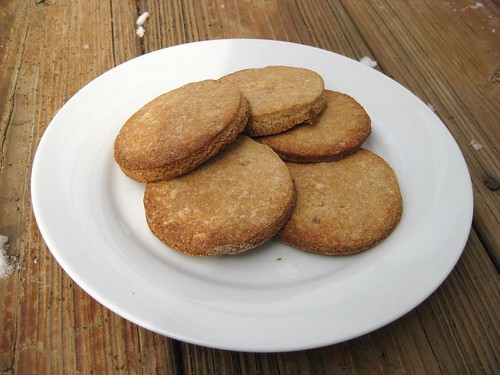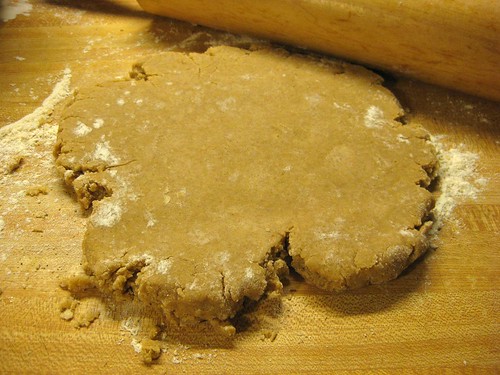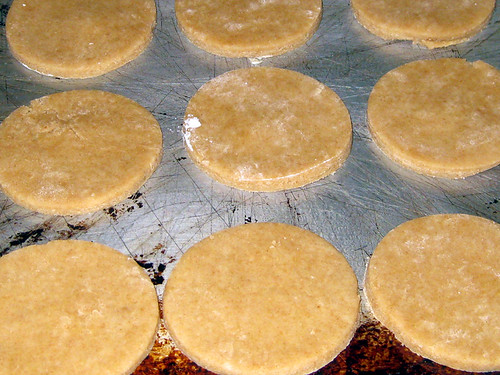There are countless recipes for gingerbread in 19th-century cookbooks, most simply called “gingerbread” (or, to distinguish them, Gingerbread No. 1, Gingerbread No. 2, and so on), but most of the recipes fall into a few types. There’s soft gingerbread, which is what we’d call a cake. There’s “common gingerbread,” which is typically a soft cookie and always contains molasses — which is what made it “common,” molasses being cheaper than even brown sugar. “Sugar gingerbread,” by contrast, used sugar. And then there’s hard gingerbread, which was designed to keep well.
I assumed that hard gingerbread would give me something like a gingersnap (or, I hoped, like Sweetzels Spiced Wafers). But this recipe, at least, turned out completely different from what I expected — somewhere between a cookie and a cracker, rather like an English biscuit. Which is, as they say, why you play the game.
Hard gingerbread
I found several recipes for hard gingerbread, all different. Some called for molasses. Others used sugar — common sugar, I assume, or a light brown, since they don’t specify white. I didn’t find any that called for cinnamon, nutmeg, or clove in addition to the ginger, but some called for rose water, others for caraway, one (disturbingly) for rose water and caraway. Some used melted butter, while others wanted you to work the butter in with your hands. Where to start?

This week’s historical gingerbread is brought to you by Sarah Josepha Hale, a 19th-century writer and editor and the Mother of Thanksgiving.
In the first half of the 19th century there were a few women who had a particular influence on American cooking. One of them was Sarah Josepha Hale, who was for decades the editor of Godey’s Lady’s Book, the most popular (and nearly the only) antebellum women’s magazine in the United States. In that role she became something of an arbiter of good taste, both figuratively and literally. Her recipes, published both in Godey’s and in her own cookbooks, combined the wholesome and reliable with more exotic and cosmopolitan ingredients, like garlic and curry powder. She also wrote “Mary Had a Little Lamb” and campaigned to make Thanksgiving a national holiday, and for that alone is more than deserving of immortalization in bobblehead.
Given the choice of authors, then, I figured Mrs. Hale would know what she was talking about. Here’s her original recipe:
Rub half a pound of butter into a pound of flour; then rub in half a pound of sugar, two table-spoonfuls of ginger and a spoonful of rose-water; work it well; roll out and bake in flat pans in a moderate oven. It will take about half an hour to bake. This gingerbread will keep good some time. The Good Housekeeper, or The Way to Live Well and to Be Well While We Live (Boston: Weeks, Jordan & Company, 1839), p. 88.
This took a few tries to adapt. You have to add liquid to make this into any kind of dough, and I learned the hard way that you do not want that liquid to be additional rose water, because the result is like eating your grandmother’s hair.
As with Amelia Simmons’ gingerbread cakes, the predominant flavor here is ginger. The rose water softens the flavor and adds complexity, but it plays a supporting role — unlike, say, cinnamon or clove, which would compete with the ginger. It’s actually quite a well-constructed, restrained pairing, not at all like the modern tendency to dump half the spices in the cabinet into gingerbread.
It’s the texture that surprised me — crisp but a little flaky, like a cracker or a hard biscuit. Without creaming or melting the butter, though, you can never get it totally incorporated into the flour. Even throroughly rubbed in (see the instructions below), the butter forms little crumbs that melt in the oven, release their moisture as vapor, and cause the dough to rise slightly, which makes the finished cookie flaky. And since they’re spicy and only lightly sweet, they don’t exactly scream cookie. But you could serve them as cookies, with tea. Or you could serve them in place of crackers, with cheese — I’m thinking blue cheese would go well with them, or else a young Gouda or Havarti. Or you could just sit there and eat them off the cooling rack, which is what happened when I made them at home.
Whatever you do with them, you should make them, because they’re really good.
A quick word about technique: You’ll have to get your hands dirty, but the dough is forgiving — remember 19th-century kitchens did not have refrigerated butter, ice water to keep the dough cold, precise temperature controls for baking, or any of those fancy-pants niceties your modern cookbooks call for. You couldn’t have gotten persnickety about this in 1839, so there’s no point doing it now.
Recipe: Mrs. Hale’s hard gingerbread
You can buy rose water at a Middle Eastern market or specialty foods store. Try to find a brand that lists simply “distilled rose petals” as the ingredient, rather than a bunch of flavorings. If you can’t find it or don’t want to bother, try the ginger-orange variation.
Makes about 3 dozen cookies.
Ingredients
- 2 1/2 cups all-purpose flour
- 1 cup whole wheat flour
- 1/2 teaspoon salt
- 2 tablespoons ground ginger
- 1 cup (2 sticks) butter
- 1 cup light brown sugar
- 2 teaspoons rose water (or see variation)
- about 1/2 cup cold water
Preparation
- In a large bowl, whisk together the flours, salt, and ginger.
- Cut the butter into small pieces and add it to the flour mixture. Pinch the pieces of butter between your fingers to break them up, and rub the mixture between your hands to work it in. Keep at this until there are no large pieces of butter left and the mixture looks like wet sand (or coarse cornmeal, but it’s more fun if you think of it as wet sand). Add the sugar and, again, rub the mixture between your hands to combine everything and break up the clumps.
- Add the rose water and stir in with a fork. Add about 1/3 cup of the water and stir with a fork, then add more water by tablespoons until the mixture will just barely hold together as a dough. Test it by squeezing some in your hand: If it will hold together when you squeeze it, you’ve added enough water, even if it’s still a little crumbly around the edges. It will come together better as you roll it out.
- Roll the dough out 1/8-inch thick and cut into whatever shapes you like — a biscuit cutter will make nice rounds, but you could get fancier. Bake at 350°F for 18–20 minutes or until golden brown and hard around the edges. (I needed 17–18 minutes, but I have a convection oven, so your results may vary.) Cool on racks. The cookies will harden as they cool.
Variations
- Ginger-orange biscuits: Omit the rose water and add, instead, the grated zest of an orange and 1/4 cup fresh orange juice, plus 1/4 cup or so of cool water to make a dough. This is what I did the first time I tried the recipe, before I’d had a chance to buy rose water, and it worked well. Orange blossom water was sometimes substituted for rose water, and 19th-century gingerbreads often called for candied orange peel, so this is a historically accurate flavor profile, if you care about that sort of thing.
- In the food processor: If you have an industrial-sized food processor, you can add the flour, salt, and ginger to the bowl and process for 10 seconds to combine, then add the flour and process for 30 seconds or so, then the brown sugar and process again. Add the rose water, then drizzle the water in with the motor running until it starts to clump up. I admit I haven’t actually tried this, but it works for pie dough, so it ought to work here.


